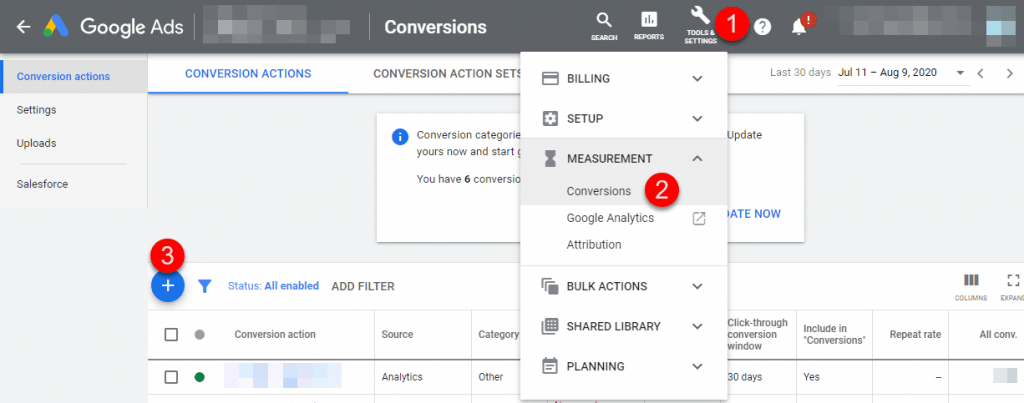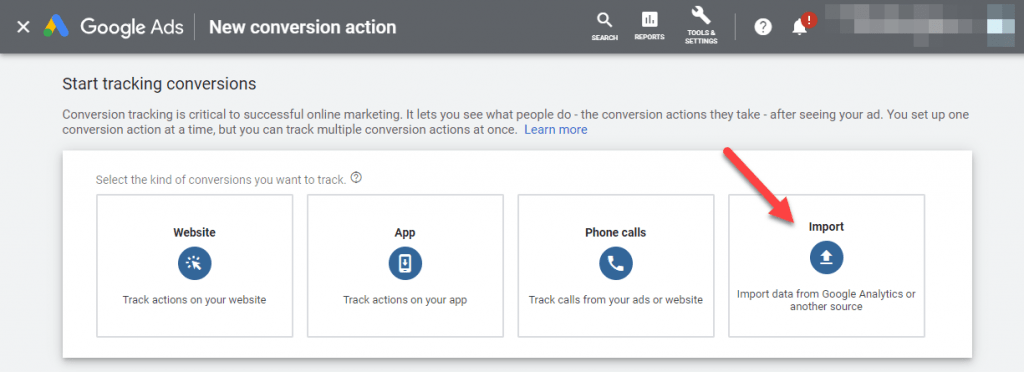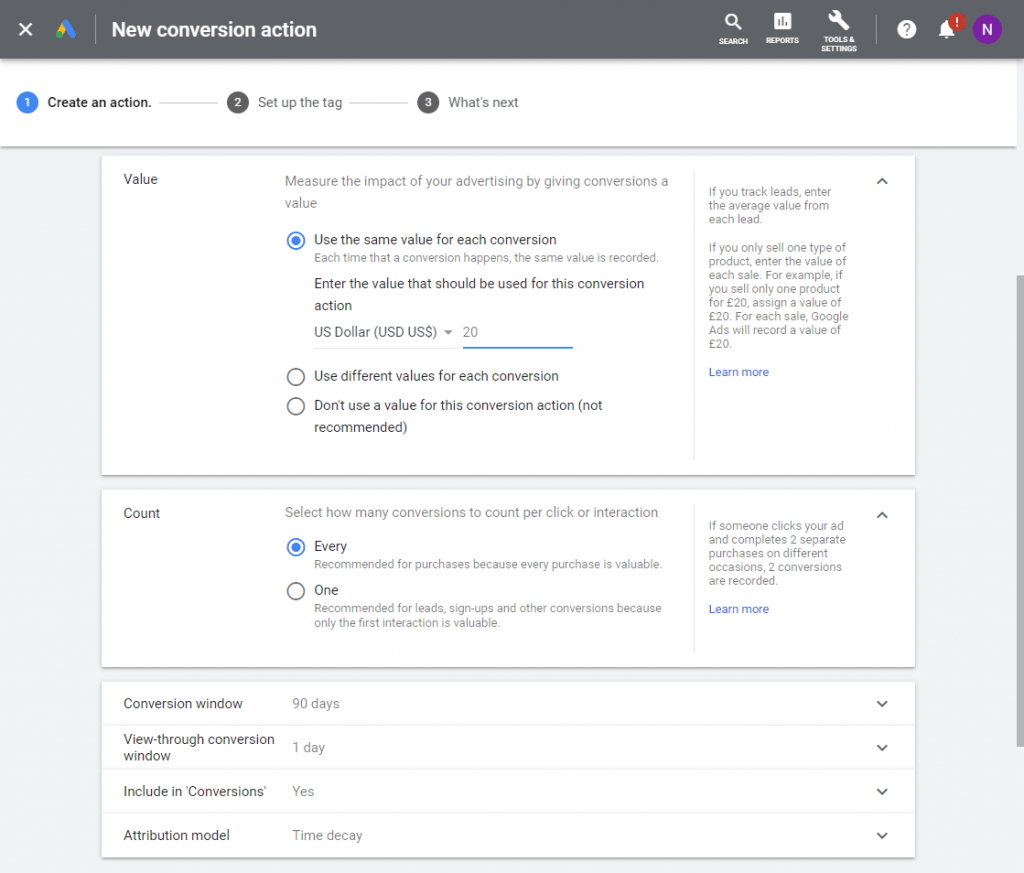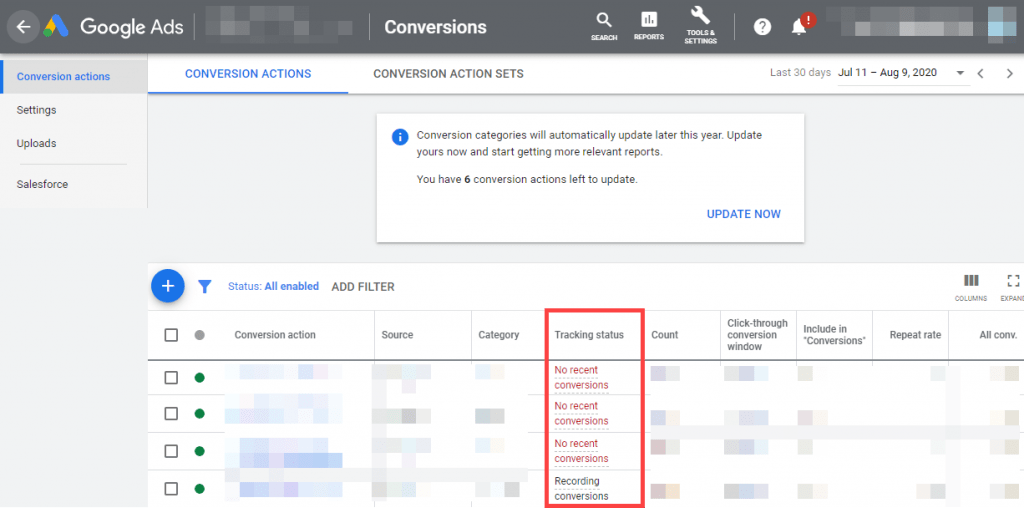In the dozens of Google Ad Grants accounts I’ve reviewed, the most common and serious mistake is misconfigured conversions.
Conversions are the goals your organization wants to achieve with your campaigns (donations, partners, volunteers, etc.).
If we do not have well defined conversions, it is almost impossible to have good results in Google Ads. A bad choice or configuration of the conversions brings important problems :
- You will lack information to optimize your campaigns . You won’t be able to tell which keywords, ads, or landing pages are performing well and which are a disaster.
- Google’s Artificial Intelligence will be disoriented and will malfunction . If your system does not know your goals well, it is impossible for it to help you achieve them well.
- They can deactivate your Google Ad Grants account (having well-configured conversions is one of the requirements since 2018).
1. Define your objectives, without forgetting the objectives of the people
The first thing is to determine what your organization wants to achieve with Google Ad Grants campaigns.
But it’s important to keep in mind that some goals can be tricky to achieve with Google Ads, because you depend on what people are searching for on Google.
For example, it is not usually easy to get a large volume of direct donations, because few users go to Google to find an NGO to donate immediately and there is fierce competition for those few users (many organizations even pay for these ads, to always appear above the free Ad Grants ads).
Because of this, it’s generally best to focus on what a lot of people are searching for on Google (and think about how that fits in with the different goals of your organization).
It is more complicated to do the opposite (trying to “push” users towards a certain goal, even though hardly anyone is searching Google with that intention).
2. Frequent goals
Each organization has different goals, but the most frequent conversions for nonprofits are:
- Get donations (online, offline, in-kind, memberships…)
- Increase event attendees (online or in-person)
- Increase online sales (products or services, tickets for events…)
- Get users to organize more campaigns or ”peer-to-peer” fundraising events
- Capture emails (newsletter subscribers, possible donors…)
- Increase followers on social media
- Recruit volunteers
- Collect signatures for petitions
- Reach beneficiaries or clients of the organization’s programs
- Attract sponsors or corporate partners
- Increase calls
- Increase online chats
- Receive more emails
- Promote specific campaigns (e.g., Giving Tuesday, Christmas cards…)
- Increase visits to certain web pages
- Increase visits to informative articles that are fundamental to the organization’s mission
- Increase downloads of certain online resources (PDFs, tools, apps…)
- Increase interactions with certain Web contents (videos, surveys, search engines, buttons to print or share on social networks…)
Conversions can be framed in 2 categories:
- Macro-conversions : Actions with a direct and significant impact on the organization. For example, receiving a donation or adding a new volunteer.
- Micro-conversions : Actions whose impact on the organization is indirect and/or not very valuable. For example, the user signs up for the newsletter, completes a form to request information or visits the page of a campaign or important event.
A very common mistake is to count only macro-conversions , which tend to be less frequent (which harms the performance of Google’s Artificial Intelligence, which “learns” better with more volume of conversions) and does not give us a complete picture of everything. the value that a campaign is generating (usually the total value is a few macro-conversions and many micro-conversions)
3. Set value for conversions
Both Google Ads and Google Analytics allow you to set a monetary value for each conversion.
For example, you can indicate that a donation has an average value of €50 and that each new newsletter subscriber has an approximate value of €3 for your organization.
First of all, it’s worth mentioning that some prefer not to set values for all conversions (either because it’s easier to set up, they don’t want to set approximate values for conversions that don’t have a clear monetary value, or other reasons).
Advantages of setting a monetary value
In my opinion, setting a monetary value for all conversions is highly recommended . It takes little time to configure and brings several very interesting advantages:
1) It allows complete analyzes to be carried out much more easily and quickly
If we have configured the monetary value of each conversion, basically in 10 seconds we can consult the value that each campaign, each keyword, etc. brings. (we will see that value already added automatically in all reports).
On the other hand, if we do not have the value configured, we will only have the number of conversions, which is normally a mixture of different conversion types with very different values. That number will not allow us to know which campaigns or keywords are bringing more value. And if we want to know, we will have to go to do manual calculations.
This is useful for analyzing the results and profitability of all marketing initiatives, not just Google Ads.
2) Allows us to use the ” Maximize conversion value ” bidding strategy
In many cases, it is the strategy that provides the best results for Google Ad Grants.
Most Ad Grants accounts are set up with the “Maximize Conversions” strategy, which is not a bug, but has the problem of not taking into account that some conversions have much more value than others (for example, a new donor vs. a newsletter subscriber). And so AI tends to focus on the easiest conversions to achieve, which tend to be the ones with the lowest value.
With “Maximize conversion value” we tell the AI to take into account the value of each conversion and try to bring the maximum value possible (which is really what 99% of organizations want).
N OTE: The “Maximize Conversion Value” strategy tends to work best when you’ve already accumulated a lot of data (so don’t turn it on right after you set up your conversion values). And although it is theoretically the best option, it is not the one that gives the best results in 100% of cases (which is why it is usually advisable to do Google Ads experiments , not change the strategy directly).
3) It gives us flexibility in setting up conversions
It allows us to mix micro-conversions and macro-conversions without problem, reflecting the total value that we are generating with the campaigns.
For example, we may want to count visits to a certain page as a conversion (because it has a certain value for the organization). But maybe that has 100 times less value than a completed donation. We don’t want to count them as having the same value.
This could be an issue with certain settings, but it’s not if we set the values and bid on “Maximize Conversions Value”. The AI will know what value each conversion has for us and will find the balance that maximizes the total value that the organization obtains.
Set conversion values
Obviously, the ideal is that the values we set are as precise as possible, but it is better to have approximate values obtained with a quick calculation than not setting any value.
When making calculations, I recommend following 3 steps:
1) First of all, if you are already getting exact values of certain conversions through e-commerce tracking (that is, if your donation or sales system is already integrated with Google Analytics and sends the exact value of each transaction), We will use those values. Therefore, for conversions that are included in e-commerce, we will not set any value “by hand”, we will use the exact value of the transactions that is automatically sent to Google Analytics.
2) For transactions that have a monetary value but are not included in electronic commerce, it is convenient to average. For example, if the average donation your organization receives is €50, we will put a value of €50 to the “donation completed” conversion.
3) For transactions that do not have a real monetary value (for example, volunteers, newsletter subscribers, etc.) we will try to approximate it with relative values, perhaps using the conversions that do have a monetary value as a reference. For example, if we have valued the donation at €50 and for your organization a volunteer has approximately 10 times less value than a donor, we will put a value of €5 on the “volunteer registration” conversion (€50 / 10 = €5 ).
4. Conversion settings in Google Analytics
It’s almost always best to set up conversions in Google Analytics first, then import them into Google Ads. Among other things, because that way you will already have them configured to analyze the results of all your marketing initiatives (not only for Google Ads).
Since there are already many guides and videos explaining this, I won’t expand here. I put some links, but just by searching on Google or Youtube you can find more guides if you need it:
For Universal Analytics (the “old” version of Google Analytics):
For Google Analytics 4 (the new version):
- Official guide
- Detailed guide (unofficial, in English)
- Guide to configure the most frequent conversion type (unofficial, in English)
Google Analytics 4 is the only version that will work from July 2023, so if you have to configure conversions from scratch, I recommend that you do it directly in this version.
If you already have conversions configured in Universal Analytics, the system will probably allow you the option to import them directly into Google Analytics 4 (depending on the tracking code you are using). In any case, it’s a good time to “clean up” (don’t import some conversions if they’re no longer relevant, and maybe create new ones).
5. Conversion settings in Google Ads
To configure new conversions, you must enter the top menú ”TOOLS AND SETTINGS” > “MEASUREMENT” section> “Conversions” and then click on the blue ”+” button

In general, we recommend to import the goals from Google Analytics. You don’t have to import all the goals you have in Analytics, only those relevant to Google Ads campaigns.

If you don’t have any conversion configured in Google Analytics or you don’t have the your Google Analytics and Google Ads accounts linked, you should fix it as soon as possible (these are serious errors and relatively easy to fix).
You may find it easier to set up conversion tracking using Google Tag Manager. You have more information about setting up events and goals using Google Tag Manager in this official video.
You also have to think carefully about the configuration of each conversion inside Google Ads. You should think about the following questions:
- What is the value of each conversion? Even for conversions without a clear monetary value, we recommend giving an approximate value based on internal data or according to your organization’s priorities. That way, Google AI can know which goals are most valuable to your organization. For example, recruiting a new volunteer probably has a high value for the organization ($300 maybe), while a new newsletter subscriber will have significantly less ($10 maybe).
- Does it have value every time the user does it or only the first time? Accordingly, we will configure it to count several conversions or only one if the same user completes that action several times. For example, if a user makes 5 donations it has value those 5 times (so we will select ”All” in the ”Count” section). But if a user sends the subscription form to the newsletter 5 times it’s not more valuable than if they send it only 1 time (so we will select ”One” in the ”Count” section).
- How soon is it reasonable to expect a conversion? Accordingly, we will configure the time of the post-click conversion window. In general, we recommend setting it to the maximum of 90 days, especially for macro-conversions that usually take more time (for example, users can take weeks or months to decide to donate)
- Which attribution model fits best? In general, we recommend ”Time decay”, not ”Last click” as it comes by default. You can see more details of the different attribution models in this link and this video.
Here you can see the data Google Ads will request when configuring a new goal:

You can find more information about how to configure each conversion in this article in Google Ads. Although as we have mentioned above, in general we recommend configuring the goals in Google Analytics and importing them into Google Ads.
4.3. Review existing conversions
If you have an account with campaigns already running, we recommend checking that the conversions are configured properly.
You can check this in the top menu of ”TOOLS” > then ”MEASUREMENT” > “Conversions”.

Possible errors or problems you may encounter:
- If on that page you see that there is no conversions configured, you should set up one conversion (or several) as soon as possible.
- If it shows any conversion with an error in th e”Status” column, check their settings.
- If they are well configured but are receiving 0 conversions (or very few), you should probably add new conversions that have more volume (Google’s AI don’t work well without very low conversion volume).
- If your Google Ads account includes goals that are not really a priority for your organization (for example, that visitors stay for more than X seconds on your website), we recommend removing them. You should leave only the goals/conversions that really have a clear value for your organization (new donations, volunteers, subscribers, event attendees…). This is especially important if you are already spending all your Google Ad Grants budget ($329/day).

For more information on how to check and configure conversions in Google Ads, you can read this article.